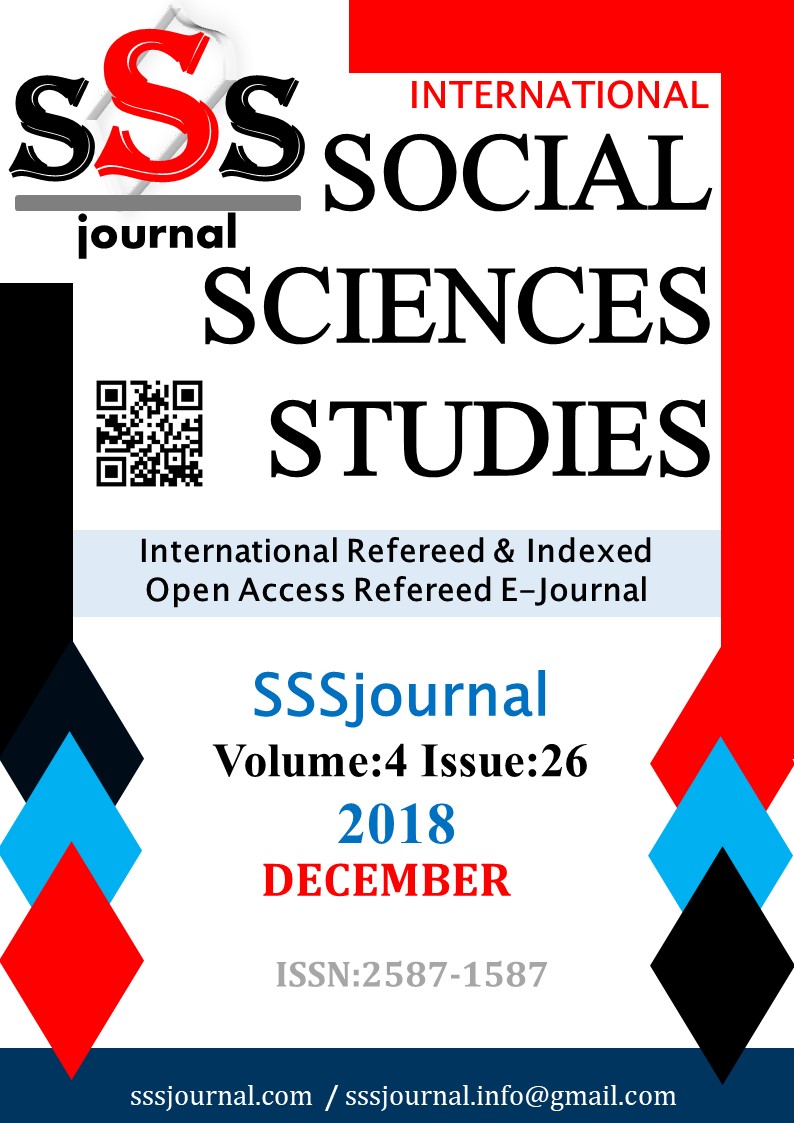Author :
Abstract
Bu çalışmanın amacı, tarihi ve turistik bölgelere yaptığı ziyaret sonrası sosyal medya üzerinden değerlendirmelerini paylaşan yerli ziyaretçilerin yorumlarının sınıflandırılmasıdır. Bu çerçevede, makine öğrenmesi yöntemlerinden denetimli öğrenme yaklaşımı kullanılarak sosyal medyada duygu analizi çalışması yapılmıştır. Analiz için Türkiye’nin turizm için önemli görülen iki turizm destinasyonu İstanbul ve Antalya’ya yönelik yerli ziyaretçilerin yorumları TripAdvisor.com’dan alınmıştır. Yorumlar olumlu, olumsuz ve nötr olarak işaretlenerek sınıflandırılmıştır. Çalışmada olumlu, olumsuz ve nötr sınıftaki veri dağılımı KNIME Programı’nda işlenerek denetimli öğrenme modellerinden karar ağaçları öğrenme yöntemiyle sınanmıştır. Denetimli öğrenme modellerinden Karar Ağaçları Öğrenme testi sonucunda başarı oranı %75,7 olarak bulunmuştur.
Keywords
Abstract
The aim of this study is to classify the local visitors’ reviews shared on social media after their visits to historical and touristic regions. In this context, sentiment analysis was conducted for social media reviews by using supervised learning approach from machine learning methods. For the analysis, the local visitors’ reviews, on Istanbul and Antalya, which are Turkey’s two important tourism cities, were imported from TripAdvisor website. The reviews were classified as positive, negative, and neutral. In the study, the data distribution was processed in positive, negative, and neutral classifications with KNIME software, and then it was tested with the learning method of decision trees from the supervised learning models. As a result of the decision trees learning test that is one of the supervised learning models, 75.7% was found as the success rate.
Keywords
- Adak-Kaplan, B. (2016). Twitter üzerindeki Türkçe mesajlarda veri madenciliğiyle duygu analizi.
- Adak-Kaplan, B. (2016). Twitter üzerindeki Türkçe mesajlarda veri madenciliğiyle duygu analizi. Yayınlanmamış Yüksek Lisans Tezi. İstanbul: Beykent Üniversitesi Fen Bilimleri Enstitüsü.
- Agarwal, A., Xie, B., Vovsha, I., Rambow, O., & Passonneau, R. (2011). Sentiment analysis of Twitter data.In, Proceedings of the Workshop on Languages in Social Media (pp. 30-38). Association for Computational Linguistics.
- Andrew, L. M., Raymond, E. D., Peter, T. P., Dan, H., Andrew, Y. N., & Christopher, P. (2011). Learningword vectors for Sentiment Analysis. In, Proceedings of the 49th Annual Meeting of the Association for Computational Linguistics, (pp. 142–150), Portland, Oregon, June 19-24, 2011.
- Can, U., & Alatas, B. (2017). Duygu Analizi ve Fikir Madenciliği algoritmalarının incelenmesi. Int. J. Pure Appl. Sci. 3(1), 75-111.
- Çoban, Ö., Özyer, B., & Tümüklü-Özyer, G. (2015). Sentiment Analysis for Turkish Twitter feeds. 23nd Signal Processing and Communications Applications Conference (SIU).
- Eley, B., & Tilley, S. (2009). Online Marketing Inside Out. Austraila, Sitepoint Pty. Ltd.
- Gao S., Hao, J., & Fu, Y. (2015). The application and comparison of web services for Sentiment Analysis intourism. In Service Systems and Service Management (ICSSSM), 2015 12th International Conference on (pp. 1-6). IEEE.
- Go, A., Bhayani, R., & Huang, L. (2009). Twitter sentiment classification using distant supervision. CS224N Project Report, Stanford, 1-12.
- Kasaba, E., & Yıldıztepe, E. (2016). Destek vektör makinesi yöntemi ile bir duygu çözümlemesi. Akademik Bilişim.
- Kaynar, O., Yıldız, M., Görmez, Y., & Albayrak, A. (2016). Makine öğrenmesi yöntemleri ile DuyguAnalizi. International Artificial Intelligence and Data Processing Symposium (IDAP'16), September 17-18, Malatya/TURKEY, pp. 234-241.
- Kouloumpis, E., Wilson, T., & Moore, J. D. (2011). Twitter sentiment analysis: The good the bad and the omg!. Fifth International AAAI Conference on Weblogs and Social Media, 11, 538-541.
- Mayfield, A. (2008). What is social media? iCrossing. http://www. icrossing. co. uk/fileadmin/uploads/eBooks/What_is_Social_Media_ Crossing_ebook. pdf.
- Medhat, W., Hassan, A., & Korashy, H. (2014). Sentiment Analysis algorithms and applications: A survey. Ain Shams Engineering Journal, 5, 1093-1113. doi.org/10.1016/j.asej.2014.04.011
- Meriç, M., & Diri, B. (2014). Twitter üzerinde duygu analizi. IEEE 22. Sinyal İşleme ve İletişim Uygulamaları Kurultayı, s. 23-25.
- Nizam, H., & Akın, S. S. (2014). Sosyal medyada makine öğrenmesi ile duygu analizinde dengeli ve dengesiz veri setlerinin performanslarının karşılaştırılması. XIX. Türkiye'de İnternet Konferansı.
- O’Connor, P. (2008). User-Generated content and travel: A case study on Tripadvisor.com. In O’Connor P.,Höpken W., Gretzel U. (eds), Information and Communication Technologies in Tourism, Springer, Vienna, pp. 47-58. doi.org/10.1007/978-3-211-77280-5_5
- Oğul, B. B., & Ercan, G. (2016). Türkçe otel yorumlarından Duygu Analizi. 24th Signal Processing andCommunication Application Conference (SIU), 16-19 May 2016, Zonguldak, Turkey. doi.org/10.1109/SIU.2016.7495786
- Onan, A. (2017). Sentiment Analysis on twitter messages based on Machine Learning Methods. Yönetim Bilişim Sistemleri Dergisi, 3(2).
- Quan, S., & Wang, N. (2004). Towards a structural model of the tourist experience: An illustration from food experiences in tourism. Tourism Management 25, 297–305. doi:10.1016/S0261-5177(03)00130-4
- Pak, A., & Paroubek, P. (2010). Twitter as a corpus for Sentiment Analysis and opinion mining. In LREc, 10(2010), 1320-1326.
- Pang, B., & Lillian L. (2008). Opinion mining and sentiment analysis. Foundations and Trends® in Information Retrieval, 2(1–2), 1-135.
- Pang, B., Lee, L., & Vaithyanathan, S. (2002). Thumbs up?: sentiment classification using machine learningtechniques. Proceedings of the ACL-02 conference on Empirical methods in Natural Language Processing, Philadelphia, July 2002, pp. 79-86. Association for Computational Linguistics.
- Seker, S. E. (2015). Sosyal ağlarda veri madenciliği (Data mining on social networks). YBS Ansiklopedi, 2(2), 30-39.
- Stepchenkova, S., & Zhan, F. (2013). Visual destination images of Peru: Comparative content analysis ofDMO and user-generated photography. Tourism Management, 36, 590-601. doi.org/10.1016/j.tourman.2012.08.006
- Wilson, T., Wiebe, J., & Hoffmann, P. (2005). Recognizing contextual polarity in phrase-level sentimentanalysis. In Proceedings of the conference on human language technology and empirical methods in natural language processing (pp. 347-354). Association for Computational Linguistics.
- Xiang, Z., & Gretzel, U. (2010). Role of social media in online travel information search. Tourism Management, 31(2), 179-188. doi.org/10.1016/j.tourman.2009.02.016





